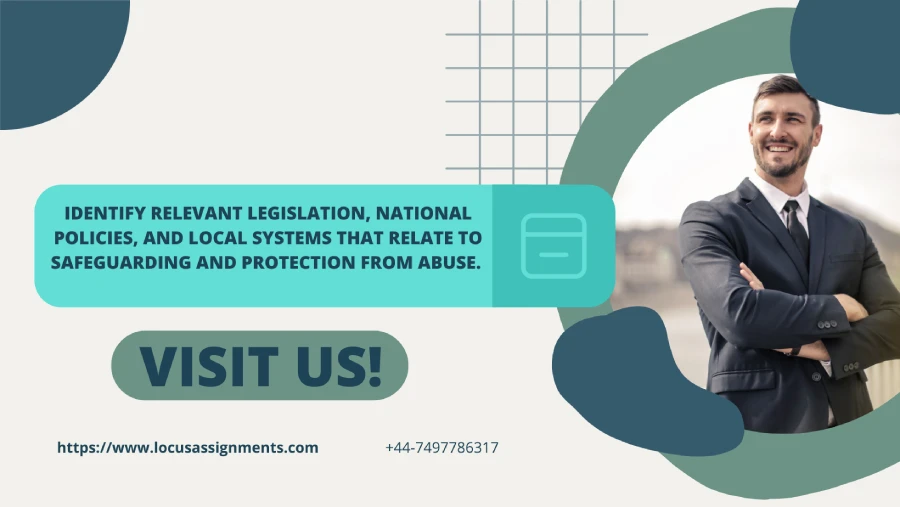Identify laws, policies & systems for safeguarding & abuse protection

4.1. Identify relevant legislation, national policies, and local systems that relate to safeguarding and protection from abuse.
Course – Level 3 diploma in care (RQF)
Unit 7 – Safeguarding and Protection in Care Settings
L.O 4 – Understand the national and local context of safeguarding and protection from abuse
Relevant legislation, national policies, and local systems underpinning safeguarding and protection from abuse in care settings are essential for care workers to understand to protect the rights and welfare of vulnerable people.
Legislation gives the legal structure identifying rights, responsibilities, and protocols to take action aimed at preventing and responding to abuse:
The Care Act 2014 provides the backbone to adult safeguarding. It outlines the duties of local authorities to make enquiries where there is suspicion of abuse, establish Safeguarding Adults Boards (SABs), and promote the well-being of adults who may be at risk. In doing so, the Care Act sets out the expectation to prevent and protect from neglect and harm.
The Children Acts 1989 and 2004 provide a protection framework for children and young people and place an obligation on local authorities to safeguard and promote the welfare of a child. Local authorities must work together (multi-agencies) to safeguard children and hear what children say about issues of concern.
The Safeguarding Vulnerable Groups Act 2006 assists in preventing unsuitable people from working with children or vulnerable adults through the establishment of the Disclosure and Barring Service (DBS), which carries out appropriate checks.
The Mental Capacity Act 2005 safeguards the rights of people who are incapable of making decisions about themselves so that decisions can be made in their best interests, including the Deprivation of Liberty Safeguards (DoLS) to safeguard personal liberty.
Other legislation relates to specific types of abuse and protection, such as the Equality Act 2010 (which protects against discriminatory abuse), Human Rights Act 1998 (which concerns key freedoms), Health and Social Care Act 2012, the Modern Slavery Act 2015, and the Female Genital Mutilation (FGM) Act 2003
Finding it difficult to structure assignments on safeguarding laws like the Care Act or MCA? Get expert assignment help in the UK to simplify complex policies and write high-scoring answers.
National policies provide direction and frameworks for safeguarding practice that work alongside legislation:
Working Together to Safeguard Children sets out an approach to multi-agency working to protect children through collaboration with partners alike.
The No Secrets guidance looks at multi-agency procedures to safeguard adults at risk from abuse or neglect.
The Making Safeguarding Personal makes outcomes-based protection and safeguarding the aim by prioritising the individual’s voice, wishes, and desire for protection.
The Mental Capacity Act Code of Practice and Deprivation of Liberty Safeguards provide practical instructions on how to operate per the Mental Capacity Act.
Regulatory agencies such as the Care Quality Commission (CQC) provide oversight on standards of care by ensuring that organisations are compliant with safeguarding, bringing in some consistency across organisations upholding standards in safeguarding.
Local systems implement safeguarding policies and legislation at the ground level:
Local Safeguarding Adults Boards (SABs) and Local Safeguarding Children Boards (LSCBs) help clasp all aspects of safeguarding practice across different sectors of social care, health, and others.
Multi-agency Risk Assessment Conferences (MARACs) share information about high-risk domestic abuse cases.
Schools and health trusts often have their own local safeguarding board or committee to implement and provide oversight of local safeguarding policy and practice.
Local authorities are responsible for participating in investigations and carrying out investigations of safeguarding allegations and are working with police and other agencies to protect individuals.
Strong organisational policies such as safeguarding, whistleblowing, and confidentiality policies support strong practices and reporting mechanisms.
In summary, effective safeguarding and protection from abuse are based on a robust structure of legislation, national policy, and local systems being joined up. These combined efforts mean that vulnerable people are protected through prevention, early intervention and appropriate and timely responses to abuse when it happens in care settings. For care workers, it is critical that they have knowledge and understanding of these systems so that they feel empowered to use them, which can ensure safety and dignity for everyone they care for.
Assignment help?
Expert Assignment Helpers are just one click away!
Fast • Reliable • Expert Support
Upload NowOther Assignments